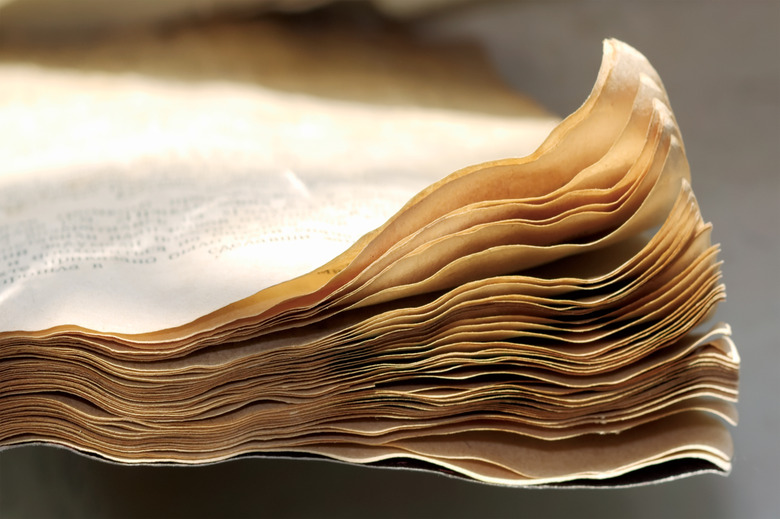How To Repair Book Pages Warped By Humidity
Though you may not notice it most of the time, paper absorbs moisture from the air during periods of high humidity. Excessively damp environments could cause a book's pages to warp, almost as if exposed directly to water. Restoring a book's original shape to remedy the warp is best done by taking the book out of the damp environment, drying out any moisture felt on the pages, and flattening the book beneath heavy objects.
Seek Dry Conditions
If the book is in a damp environment, such as a basement that recently flooded, remove it from the area immediately, as the longer it sits in humid conditions, the worse the warping. Finding even one book in such condition in your home means other books in the same area are likely affected as well. Look around and remove all books from the room if you feel the room's damp environment is to blame.
Take the affected books to a dry location with less humidity. While leaving them on a porch may sound like a good idea, if you live anywhere with humid conditions, the book's pages may still absorb moisture. Setting the books in the sun for a bit helps some of the moisture to evaporate.
Removing Actual Moisture
In some cases, the book pages may actually feel damp, as with the flooded basement scenario. If you suspect the pages may be holding some moisture, stand up the book opened at less than a 60-degree angle to let the pages air out. This works best on a sunny day outdoors with no breeze, but it may also be done indoors in a dry location and with a low-speed fan running nearby.
Use any heavier object to prop up the book if it falls too easily or place small objects between some of the pages on the table or on the surface upon which the book sits to help the book stay open. This process doesn't remove any of the wrinkles or warping, but if the pages are so damp that you're concerned they'll stick together, it's a good idea to let them dry before flattening the book.
Flattening Book Pages
It's often possible to remove the warp from book pages, restoring the book to near its previously unwarped condition, by placing the dry book beneath a moderately heavy object for a week or so. Set the book on a smooth, untextured surface in a dry environment and then place another smooth object over it, covering the entire book. A cutting board is a good size for most books. If you feel the book cover absorbed some moisture, put plain paper towels between the cover and the book pages to absorb any remaining moisture first.
Place the weight atop the cutting board and leave it there for a week or so. The cutting board helps distribute the weight evenly so the book flattens uniformly. Good choices for weights include heavy bookends, a removable weight from a barbell set, or even a stack of heavy books. Remove the weights and cutting board and check the book after about a week.
If a few pages are still warped, gently ironing them on a low-heat setting also works, though it requires extra care not to damage the book spine or binding. Gently mist the wrinkled or warped pages with water and then smooth a sheet of parchment paper or thick office paper on the ironing board, followed by one warped book page. Smooth out the book page as much as possible and then place another sheet of office paper atop it. Iron the office paper gently for a few seconds, check it, and then repeat if necessary.
